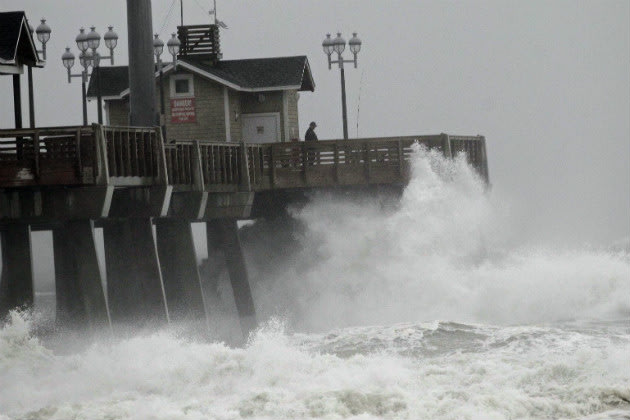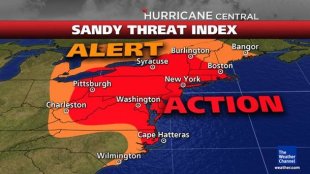NEW YORK (AP) — Millions of people from Maine to the Carolinas awoke Tuesday without electricity, and an eerily quiet New York City was all but closed off by car, train and air as superstorm Sandy steamed inland, still delivering punishing wind and rain. The U.S. death toll climbed to 38, many of the victims killed by falling trees.
The full extent of the damage in New Jersey, where the storm roared ashore Monday night with hurricane-force winds of 80 mph, was unclear. Police and fire officials, some with their own departments flooded, fanned out to rescue hundreds.
"We are in the midst of urban search and rescue. Our teams are moving as fast as they can," Gov. Chris Christie said. "The devastation on the Jersey Shore is some of the worst we've ever seen. The cost of the storm is incalculable at this point."
More than 8.2 million people across the East were without power. Airlines canceled more than 15,000 flights around the world, and it could be days before the mess is untangled and passengers can get where they're going.
The storm also disrupted the presidential campaign with just a week to go before Election Day.
President Barack Obama canceled a third straight day of campaigning, scratching events scheduled for Wednesday in swing state Ohio. Republican Mitt Romney resumed his campaign, but with plans to turn a political rally in Ohio into a "storm relief event."
Sandy will end up causing about $20 billion in property damage and $10 billion to $30 billion more in lost business, making it one of the costliest natural disasters on record in the U.S., according to IHS Global Insight, a forecasting firm.
Lower Manhattan, which includes Wall Street, was among the hardest-hit areas after the storm sent a nearly 14-foot surge of seawater, a record, coursing over its seawalls and highways.
Water cascaded into the gaping, unfinished construction pit at the World Trade Center, and the New York Stock Exchange was closed for a second day, the first time that has happened because of weather since the Blizzard of 1888. The NYSE said it will reopen on Wednesday.
A huge fire destroyed as many as 100 houses in a flooded beachfront neighborhood in Queens on Tuesday, forcing firefighters to undertake daring rescues. Three people were injured.
New York University's Tisch Hospital evacuated 200 patients after its backup generator failed. About 20 babies from the neonatal intensive care unit were carried down staircases and were given battery-powered respirators.
A construction crane that collapsed in the high winds on Monday still dangled precariously 74 floors above the streets of midtown Manhattan, and hundreds of people were evacuated as a precaution. And on Staten Island, a tanker ship wound up beached on the shore.
Most major tunnels and bridges in New York were closed, as were schools, Broadway theaters and the metropolitan area's three main airports, LaGuardia, Kennedy and Newark.
With water standing in two major commuter tunnels and seven subway tunnels under the East River, Mayor Michael Bloomberg said it was unclear when the nation's largest transit system would be rolling again. It shut down Sunday night ahead of the storm.
Joseph Lhota, chairman of the Metropolitan Transportation Authority, said the damage was the worst in the 108-year history of the New York subway.
Similarly, Consolidated Edison said it could take at least a week to restore electricity to the last of the nearly 800,000 customers in and around New York City who lost power.
Millions of more fortunate New Yorkers surveyed the damage as dawn broke, their city brought to an extraordinary standstill.
Reggie Thomas, a maintenance supervisor at a prison near the overflowing Hudson River, emerged from an overnight shift, a toothbrush in his front pocket, to find his Honda with its windows down and a foot of water inside. The windows automatically go down when the car is submerged to free drivers.
"It's totaled," Thomas said with a shrug. "You would have needed a boat last night."
Around midday, Sandy was about 120 miles east of Pittsburgh, pushing westward with winds of 45 mph, and was expected to make a turn into New York State on Tuesday night. Although weakening as it goes, the storm will continue to bring heavy rain and flooding, said Daniel Brown of the National Hurricane Center in Miami.
In a measure of the storm's immense size and power, waves on southern Lake Michigan rose to a record-tying 20.3 feet. High winds spinning off Sandy's edges clobbered the Cleveland area early Tuesday, uprooting trees, cutting power to hundreds of thousands, closing schools and flooding major roads along Lake Erie.
In Portland, Maine, gusts topping 60 mph scared away several cruise ships and prompted officials to close the port.
Sandy also brought blizzard conditions to parts of West Virginia and neighboring Appalachian states, with more than 2 feet of snow expected in some places. A snowstorm in western Maryland caused a pileup of tractor-trailers that blocked part of Interstate 68 on slippery Big Savage Mountain.
"It's like a long-tailed cat in a room full of rocking chairs up here," said Bill Wiltson, a Maryland State Police dispatcher.
The death toll climbed rapidly, and included 17 victims in New York State — 10 of them in New York City — along with five dead in Pennsylvania and four in New Jersey. Sandy also killed 69 people in the Caribbean before making its way up the Eastern Seaboard.
In New Jersey, Sandy cut off barrier islands, swept houses from their foundations and washed amusement pier rides into the ocean. It also wrecked several boardwalks up and down the coast, tearing away a section of Atlantic City's world-famous promenade. Atlantic City's 12 waterfront casinos came through largely unscathed.
Jersey City was closed to cars because traffic lights were out, and Hoboken, just over the Hudson River from Manhattan, was hit with major flooding.
A huge swell of water swept over the small New Jersey town of Moonachie, near the Hackensack River, and authorities struggled to rescue about 800 people, some living in a trailer park. And in neighboring Little Ferry, water suddenly started gushing out of storm drains overnight, submerging a road under 4 feet of water and swamping houses.
Police and fire officials used boats and trucks to reach the stranded.
"I looked out and the next thing you know, the water just came up through the grates. It came up so quickly you couldn't do anything about it. If you wanted to move your car to higher ground you didn't have enough time," said Little Ferry resident Leo Quigley, who with his wife was taken to higher ground by boat.
___
Hays reported from New York and Breed reported from Raleigh, N.C.; AP Science Writer Seth Borenstein contributed to this report from Washington. Associated Press writers David Dishneau in Delaware City, Del., Katie Zezima in Atlantic City, Emery P. Dalesio in Elizabeth City, N.C., and Erika Niedowski in Cranston, R.I., also contributed.




